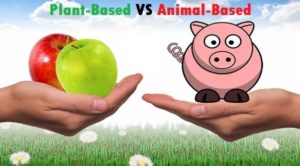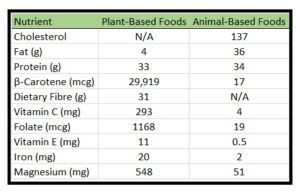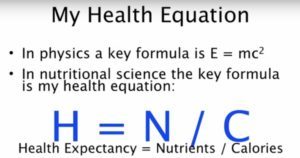
A useful resource for those interested in nutrition is the United States Department of Agriculture (USDA) group of Food Composition Databases 1 . They analyse a massive range of foods and list their nutritional content. In this brief blog, I want to give you a snap-shot of the nutrient values shown within these databases for a given amount of plant-based foods when compared with the same amount of animal-based foods.
The research data
The chart below comes from the USDA databases 2 and from the Journal of Food Composition and Analysis 3 and represents 500 calories of each of the food sources:

The plant-based foods are composed of equal parts of:
- tomatoes
- spinach
- lima beans
- peas
- potatoes
The animal-based foods are composed of equal parts of:
- beef
- pork
- chicken
- whole milk
The exact food listings in the database were:
- plant-based foods
- spinach, raw
- tomatoes, red, ripe, raw, year-round average
- lima beans, large, mature seeds, raw
- peas, green, raw
- potatoes, russet, flesh and skin, raw
- animal-based foods
- ground beef, 80% lean meat/20% fat, raw
- pork, fresh, ground, raw
- chicken, broilers or fryers, meat and skin, raw
- milk, dry, whole
Final thoughts
The above speaks for itself. As you can see, there’s much more nutritional value per calorie in plant-foods than in animal-foods, and this is apart from the myriad health problems associated with the latter compared with the former.
As Dr Joel Fuhrman pointed out 4 , Health = Nutrient Intake/Calories. That is, the more nutrient value there is per calorie of the foods you consume, the better health you should expect from your diet; on the other hand, the less nutrient value there is per calorie, the less health benefits you should expect to see.

References
- USDA National Nutrient Database for Standard Reference. [↩]
- USDA. (2016). National Nutrient Database for Standard Reference Release 28. Retrieved from: http://ndb.nal.usda.gov/ndb/search. [↩]
- Journal of Food Composition and Analysis. Volume 12, Issue 3, September 1999, Pages 169-196. [↩]
- Health = Nutrient Intake ÷ Calories [↩]